- Faculty News
- Student News
- Lab News
- Publications
- Meetings and Presentations
- Outreach
- Grants
- Announcements
- About This Newsletter
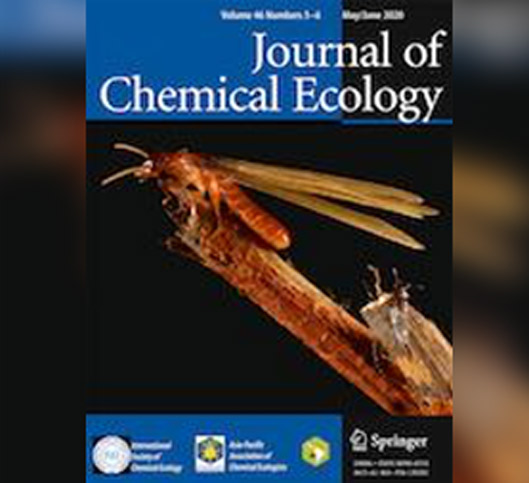
ABOVE: Journal of Chemical Ecology cover, photo by Dr. Chouvenc.

Respectfully submitted, Heather McAuslane.

Dr. Thomson Paris, M.S. and Ph.D. from the University of Florida under the supervision of Dr. Phil Stansly joined Dr. Xavier Martini laboratory at the North Florida Research and Education Center in Quincy. He will work in a collaborative project with Dr. Oscar Liburd’s lab on the development of a push-pull system for the silverleaf whitefly, Bemisia tabaci, through visual and olfactory bioassays. Welcome Thomas!

Dr. James P. Cuda was an invited ad hoc panel reviewer for the USDA ARS National Program 5 -year Project #0206-22000-003-00D, “Biological Control of Invasive Weeds and Pests from Australia and Asia."

Dr. Angela Chuang will be joining Dr. Diepenbrock’s lab at the CREC in Lake Alfred as a Postdoctoral Scholar in August 2020. Welcome Angela!
The first book on the Asian citrus psyllid (ACP) and huanglongbing (HLB) edited by Dr. Jawwad Qureshi and Dr. Phil Stansly was recently published by the Center for Agriculture and Biosciences International (CAB International). This book, written by a team of experts on the Asian citrus psyllid, gathers together everything currently known about the biology and ecology of this important pest species, examines the transmission and acquisition processes of the pathogen, and looks at current management practices and their effectiveness. The potential for new, innovative management techniques are also described along with the economic implications of managing this rapidly establishing disease. The book presents a great source of knowledge for researchers of entomology and related disciplines, students, agricultural scientists and professionals, extension agents, and pest management consultants.
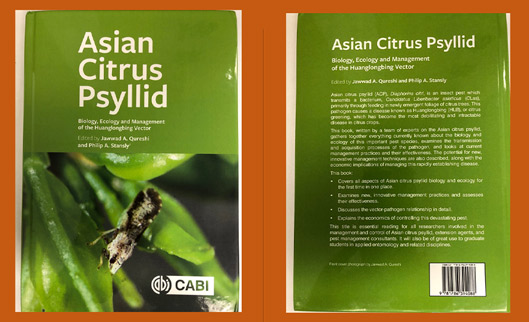
ABOVE: Front and back cover of the Asian citrus psyllid (ACP) and huanglongbing (HLB) book. https://www.cabi.org/bookshop/book/9781786394088/
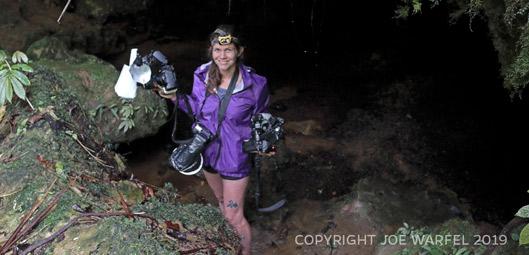
ABOVE: Dr. Erin Powell, who earned her master's degree in our department and served as the former outreach coordinator, returned to the Taylor Lab earlier this year. After spending three years earning her Ph.D. studying weapons in New Zealand harvestmen, she has returned for an NSF-funded postdoc, studying color communication and the evolution of color vision in jumping spiders. Welcome back, Erin!
Dr. Malika Ihle, former postdoc in the Taylor lab, is now the Reproducible Research Coordinator at the University of Oxford, where she is continuing her efforts to make science more open, reproducible, and reliable. You can find many of her fantastic resources on this topic here: https://malikaihle.wordpress.com/openscienceworkshop/.
Janna Josafat, an undergraduate Entomology student, joined the laboratory of Dr. James P. Cuda for the Summer B semester. Janna will be completing an ENY4905 internship that will involve cogongrass propagation.
Need to name that bug? A host of experts are available to help Floridians identify any insect or related arthropod. If a mystery creature has six or more legs, the UF Insect ID Lab is the place to call.
A couple folks recently contacted the Insect ID Lab about walnut caterpillars, Datana integerrima. These caterpillars feed on hickories and pecan, and like many Datana species, they like to feed in large groups. Young caterpillars are reddish with yellow stripes, while full-grown caterpillars are black with silky white hairs. Occasionally they build up large populations that can heavily defoliate large trees.
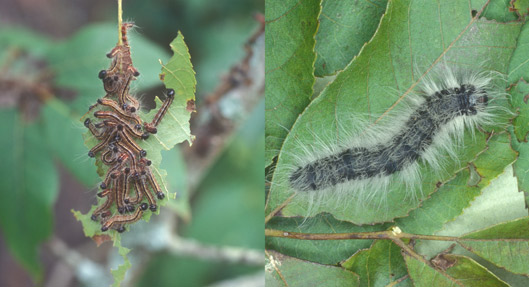
ABOVE: From left to right, young cluster of walnut caterpillars, full grown walnut caterplliar.
If you need insect images for a publication or presentation for your UF/IFAS Extension or teaching work, you can go to this direct link, pictures are copyrighted material and intended for official UF use only. Log onto the website using your Gatorlink credentials.
Lyle Buss is the UF/IFAS Insect ID Lab manager.

Think it might be a nematode problem? The Nematode Assay Laboratory serves Florida and other states by providing nematode assays and expert advice regarding nematode management.
For more information on the Nematode Assay Laboratory, please contact the lab manager Dr. Billy Crow.
Alto BW, Civana A, Wiggins K, Eastmond B, Shin D. 2020. Effect of oral infection of Mayaro virus on fitness correlates and expression of immune related genes in Aedes aegypti. Viruses 12: 719.
Chouvenc T, Sillam-Dussès D, Robert A. 2020. Courtship behavior confusion in two subterranean termite species that evolved in allopatry (Blattodea, Rhinotermitidae, Coptotermes). Journal of Chemical Ecology 46:461-474.
Cross F, Jackson RR, and Taylor LA. 2020. Influence of seeing a red face during the male–male encounters of mosquito-specialist spiders. Learning Behavior 48: 104-112.
Cuda JP. 2020. Section 1.5: Aquatic plants, mosquitoes and public health, pp. 23-26. In, Gettys LA, Haller WT Petty DG (eds.), Biology and Control of Aquatic Plants: A Best Management Practices Handbook, 4th edition. Aquatic Ecosystem Restoration Foundation, Marietta, GA.
Cuda, JP. 2020. Section 3.6: Introduction to biological control of aquatic weeds, pp. 139-144. In Gettys LA, Haller WT, Petty DG (eds.), Biology and Control of Aquatic Plants: A Best Management Practices Handbook, 4th edition. Aquatic Ecosystem Restoration Foundation, Marietta, GA.
Cuda, JP. 2020. Section 3.6.1: Insects for biocontrol of aquatic weeds, pp. 145-150. In Gettys LA, Haller WT, Petty DG. (eds.), Biology and Control of Aquatic Plants: A Best Management Practices Handbook, 4th edition. Aquatic Ecosystem Restoration Foundation, Marietta, GA.
Diepenbrock L, Burrow J. 2020. Citrus Quick Pest Guide: Lebbeck Mealybug (ENY-1005). University of Florida, IFAS, EDIS, Gainesville. https://edis.ifas.ufl.edu/pdffiles/IN/IN128000.pdf
Gloria-Soria A, Mendiola SY, Morley VJ, Alto BW, Turner PE. 2020. Evolution to stochastic temperatures in an RNA virus facilitates adaptation to novel temperatures. Ecology and Evolution 10: 5440-5450.
Halbert SE Singer B. 2020 Epidemiology of Huanglongbing: Implications of infective colonization events. Pages 140–155 in JA Qureshi and PA Stansly, Eds. Asian citrus psyllid: Biology, ecology and management of the Huanglongbing vector. CABI International. London 290 p.
Iannone II BV, Carnevale S, Main MB, Hill JE, McConnell JB, Enloe SF, Johnson SA, Andreu M, Bell EC, Cuda JP, BakerSM. 2020. Invasive species terminology: standardizing for stakeholder education. J. of Extension 58: Article #v58-3a3 (21pp.) https://joe.org/joe/2020june/a3.php
Martini X, Malfa K, Stelinski L, Iriarte F, Paret M. 2020. Distribution, phenology, and overwintering survival of Asian citrus psyllid in urban and grove habitats in north Florida. Journal of Economic Entomology. 113: 1080-1087.
Wilner D, Greenway EV, Cirino LA, Miller CW. 2020. Long-term reproductive success is predicted by sexual behavior and impaired by temporary nutritional stress during sexual maturation. Behavioural Processes 175: 104122. DOI: https://doi.org/10.1016/j.beproc.2020.104122.
Winsor A, Ihle M, and Taylor LA. 2020. Methods for independently manipulating palatability and color in small insect prey. PLoS One 15: e0231205.

New on Featured Creatures:
Red and black mason wasp, Pachodynerus erynnis (Lepeletier). Authors: Kelly Laplante, Wayne Hobbs, and Adam Dale.
Taro planthopper, Tarophagus colocasiae (Matsumura). Authors: Alexander Tasi, and Adam Dale
Do you have a favorite creature? Learn how to make it into a Featured Creatures!
Dr. Billy Crow gave a presentation on submitting nematode samples at a webinar hosted by Palm Beach County Extension on the 25th of June.
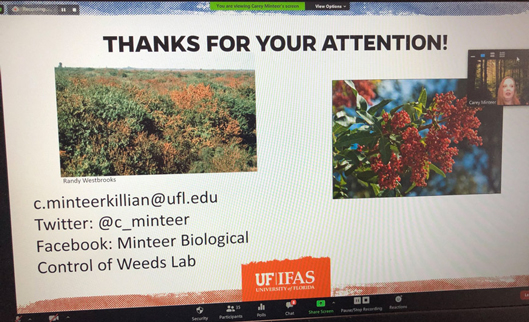
ABOVE: Kenneth T. Gioeli, Extension Agent IV in in Port St. Lucie, Florida, Dr. Minteer, and Joe Walter completed a webinar titled “New developments in Brazilian peppertree management.” on June 30th. Learn more about their biological control project here: http://blogs.ifas.ufl.edu/stlucieco/2020/01/30/brazilian-peppertree-biological-control-at-mccarty-ranch-in-port-st-lucie-fl/

Education and Outreach 2020 ANTvengers Bug Camp
The 11th Annual UF Entomology and Nematology Field Camp went virtual this year with “ANTvengers 2020” held on June 22nd to the 26th. We had 20 middle and high school participants including campers from Florida and Virginia. We also had parents and family members join in as well!
Our camp teams included the Formidable Formicidae, the Confounding Colony, ANThony, and the Wood Workers.
A big thank you to the Entomology Club members who moderated the teams, Brett LaBella, Jordyn Ranfone, Cameryn Lein, Otto Alvarez, Daniel Min, Vilheim Piwowarek, Neil Rajagopal and Genhsy Monzon. Also thank you to each of the Scientists of the Day featured in our ANTvenger themed event and to all the labs that sponsored their participation.
Campers explored ANTanomy and depictions of ants with Dr. Rebecca Baldwin, enjoyed a live video tour of the UF Urban Entomology colonies and discussed collecting and observing ants in a live question and answer by Dr. Roberto Pereira, competed against each other in a virtual ANTvenger Escape ANTventure to defeat the enemy and gain ANTvictory with Clayton Bania, want to make plans for a global tour after learning about the 35 families of beetles associated with ants by Dr. Oliver Keller, are excited to take a closer look at ant colonies after learning about spider and ant mimics by Cayley Buckner, examined ant farmers with Kelly Carruthers, explored the other Hymenoptera: Honey Bees with Baylee Carrol, discussed invasive ants with Rachel Atchison, Jacob Hornfeldt and Virginia Rose Seagal, saw the ANTamony of a sting with Clancy Short and Dylan Tussey, examined insect scientific illustration with Riley Gott, discovered ant and mite associations with Emilie Demard and investigated fire ant research and ant related global cultures with Dr. Phil Koehler.
At the conclusion of camp, the campers presented their “Colony Work” which included ant related art in a variety of mediums including, Native American motifs, drawings of ant colonies with hidden myrmecophiles, dioramas with drawings of worker, soldier and reproductive castes set in natural materials, Minecraft boards of an ant colony complete with food storage, workers, and a queen, and chemical models of formic acid. Campers were able to share their arthropod pets, cell phone magnifiers, fun hats, collecting gear, and the collections and art they are preparing to present at the 2021 Florida 4-H Insectathon!
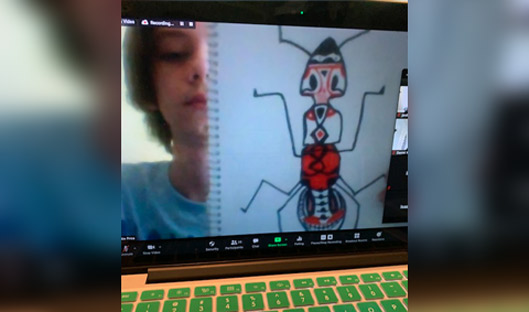
ABOVE: Camper from the Annual UF Entomology and Nematology Field Camp showing his ant related art!

The live critters are always a hit with children and adults alike. The critters are available for you to check out should you be leading an outreach event. We have doubles of our most popular critters, as well as various native insect species depending on the time of year. We have large wood and Plexiglas cages for viewing our native orb weaving spiders. There is one travel cage and one larger static cage. Please be sure to contact us and review the protocol on transporting and handling the critters if you are not already familiar with it. If you lead an outreach, be sure to fill out a documentation form so your event can be included in the newsletter and we can log all outreach events.
If you have any questions, please email me.
Thank you —Clayton Bania, Outreach Coordinator.
If you would like to schedule an event or have any outreach questions, go to the Outreach pages on our Bug Club website and contact us.
Getting social!
Use #UFBugs so our department can find and share your social posts easily!
Dr. Xavier Martini (North Florida Research and Education Center) was awarded a $168,955 grant from FDACS titled “Evaluating the efficacy of limonene-scented kaolin and two new commercialized insecticides to control whiteflies in tomatoes". Co-PI include department faculty Dr. Dakshina Seal.
Dr. Lawrence Reeves, in collaboration with Dr. Nathan Burkett-Cadena, received funding of $61,641 through the Florida Department of Agriculture and Consumer Services to investigate the non-target impacts of mosquito pesticide applications on vertebrate hosts using blood meal analysis.
Dr. Diepenbrock received a grant from CRDF for $342,111 for a two-year project working on integrated pest management strategies for Lebbeck Mealybug in citrus.
Want grant writing tips? Check out the UF Libraries Grants Management Program
The Termite Course for Professionals has been rescheduled for December 2nd to the 4th 2020. https://conference.ifas.ufl.edu/termitepro/.
The Annual UF BugFest Open House has been tentatively rescheduled for October 24th. The undergraduate Entomology Club sponsors this event that brings in 300 to 500 people to learn about the UF Entomology and Nematology Department each year.
Want to stay up to date? Check out our website home page for a link to our Google calendar.
Suzy Rodriguez is the newsletter editor and does the HTML coding. Issues usually are published by mid-month. Submit items for an issue by the seventh of that month.
We like to share news when it happens using our social media outlets: Twitter, Facebook and YouTube. Follow us on these sites for daily updates! When you send news, we will post it on one or more of these sites and again in the monthly newsletter. Please be sure you have permission from people in photographs you submit for publication.
UF-Bugnews-L listserv subscribers receive notices when issues are posted. Our home page has instructions for subscribing and unsubscribing.
Special thanks to Eleanor Phillips and Nancy Sanders, and who reviewed the newsletter for errors, and to Jane Medley and Don Wasik, who built the web page design.
Give Back
Want to support the UF Entomology & Nematology Department? Consider making an online gift today! Questions can be directed to Christy Chiarelli at (352) 392-1975 or ccw@ufl.edu.